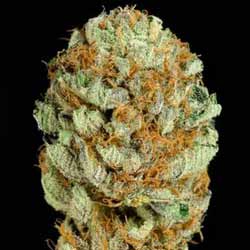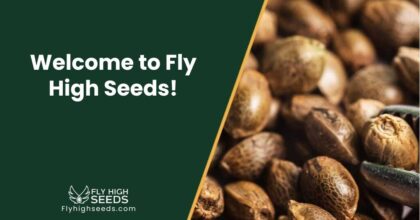
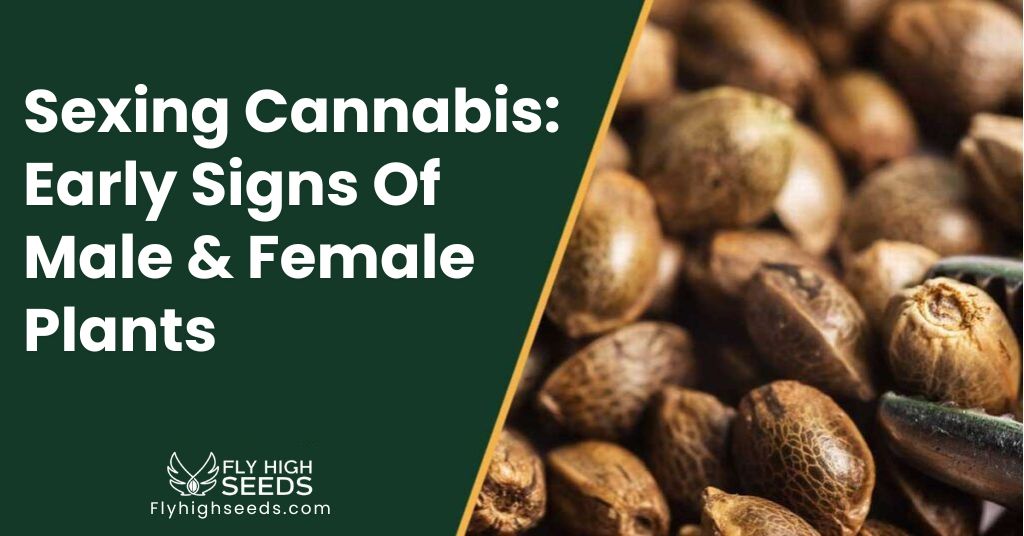
Sexing Cannabis: Early Signs Of Male & Female Plants
Sexting cannabis, a process akin to determining the gender of the plants, is a crucial step for cultivators seeking to maximize their yield and manage their cannabis garden effectively. Recognizing the early signs of male and female plants is an essential skill that allows growers to identify and separate plants based on their sex. This distinction is significant because female cannabis plants produce the sought-after flowers rich in cannabinoids, while male plants contribute to pollination and seed production. By understanding the visual cues that differentiate male and female cannabis plants, cultivators can make informed decisions to ensure a successful and productive harvest.
Table of Contents
Why Is Determining The Sex Of Cannabis Important For Growers?
Determining the sex of cannabis plants is crucial for growers due to its significant impact on cultivation outcomes. Here’s a brief summary of why sex determination is essential for cannabis growers:
- Resource Allocation: Male and female cannabis plants have different purposes. Females produce the valuable flower buds containing cannabinoids, while males contribute to pollination. Identifying and removing male plants allows growers to allocate resources, space, and care more efficiently to the female plants that yield the desired flowers.
- Cannabinoid Production: Female cannabis plants are the primary source of the cannabinoids that provide medicinal and recreational effects. Ensuring a garden primarily composed of female plants maximizes the yield of cannabinoid-rich flowers for consumption.
- Preventing Pollination: Allowing male plants to remain in proximity to females can lead to accidental pollination. This results in seed production, reducing the quality and potency of the flowers. By removing male plants, growers prevent unwanted cross-pollination and maintain the integrity of their harvest.
- Bud Development: Unpollinated female cannabis plants focus their energy on producing larger, resinous buds. Without the energy diverted for seed production, growers can expect higher-quality flowers with enhanced potency and aroma.
- Genetics Preservation: For those interested in preserving specific genetics or creating their own strains, identifying and maintaining separate male and female plants is essential for controlled breeding.
- Efficient Harvest: Knowing the sex of your cannabis plants in advance allows you to plan your harvest more efficiently. You can prioritize harvesting female plants at their peak ripeness and potency, avoiding unnecessary delays.
In summary, determining the sex of cannabis plants empowers growers to cultivate efficiently, optimize cannabinoid production, and maintain the quality of their harvest. By focusing on female plants, growers can achieve higher yields of potent, desirable flowers for consumption or breeding purposes.
What Happens If Male Cannabis Plants Flower With Females?
If male cannabis plants flower alongside female plants, it can lead to cross-pollination, which has several significant effects:
- Seed Production: Cross-pollination between male and female cannabis plants results in the development of seeds within the female flowers. This diminishes the overall quality and potency of the flower buds, as the plant redirects energy from cannabinoid production to seed development.
- Reduced Potency: The presence of seeds in female flowers reduces the concentration of cannabinoids, such as Cannabinoid and CBD, which are responsible for the plant’s psychoactive and therapeutic effects. This results in lower potency and diminished overall quality.
- Altered Flavor and Aroma: Seeds contribute a bitter and undesirable taste to the flower buds, altering the flavor and aroma of the cannabis. The rich terpene profiles that contribute to the plant’s unique scent and taste are also compromised.
- Smoking Experience: Smoking or vaping flowers with seeds can lead to a harsh and less enjoyable experience, as the seeds can create an unpleasant burning sensation and affect the smoothness of inhalation.
- Cultivation Impact: If growers are cultivating for high-quality flower production, the presence of male plants can have a detrimental impact on the overall yield and quality of the harvest. The inadvertent pollination can lead to unintended seed production in female plants.
To prevent these undesirable effects, growers typically remove male plants from their garden before they start producing pollen. This practice helps maintain the integrity of the female flowers, ensuring they develop into potent and cannabinoid-rich buds without the interference of seed development.
Feminized Vs. Regular Cannabis Seeds
Feminized and regular cannabis seeds are two distinct types that hold key differences in terms of their genetic makeup and intended outcomes:
- Feminized Seeds: Feminized cannabis seeds are bred to produce only female plants. This is achieved through various methods, such as stressing a female plant to produce male flowers, which then pollinate other females, resulting in seeds that are almost guaranteed to produce female plants. These seeds are favored by many cultivators because female plants are the ones that produce the sought-after flower buds rich in cannabinoids. Growing from feminized seeds eliminates the need to sex plants and minimizes the risk of inadvertently introducing male plants that could lead to pollination and seed production.
- Regular Seeds: Regular cannabis seeds encompass both male and female genetics in roughly equal proportions. Cultivating from regular seeds requires growers to identify and separate male plants to prevent pollination of female plants, which would lead to seed production. While regular seeds require more vigilance to achieve a successful harvest of high-quality flowers, they also offer the opportunity for breeding projects and genetic diversity preservation, which can be important for creating unique strains or maintaining specific genetic traits.
In summary, feminized seeds offer a simpler and more efficient path to growing high-quality flower buds by guaranteeing female plants. Regular seeds provide a broader spectrum of genetic possibilities but require careful attention to sexing and plant management to prevent unintended pollination. Growers should choose between the two based on their goals, whether it’s for maximizing flower yield or exploring breeding possibilities.
How Are Feminized Seeds Made
If male cannabis plants flower alongside female plants, it can lead to cross-pollination, which has several significant effects:
- Seed Production: Cross-pollination between male and female cannabis plants results in the development of seeds within the female flowers. This diminishes the overall quality and potency of the flower buds, as the plant redirects energy from cannabinoid production to seed development.
- Reduced Potency: The presence of seeds in female flowers reduces the concentration of cannabinoids, such as Cannabinoid and CBD, which are responsible for the plant’s psychoactive and therapeutic effects. This results in lower potency and diminished overall quality.
- Altered Flavor and Aroma: Seeds contribute a bitter and undesirable taste to the flower buds, altering the flavor and aroma of the cannabis. The rich terpene profiles that contribute to the plant’s unique scent and taste are also compromised.
- Smoking Experience: Smoking or vaping flowers with seeds can lead to a harsh and less enjoyable experience, as the seeds can create an unpleasant burning sensation and affect the smoothness of inhalation.
- Cultivation Impact: If growers are cultivating for high-quality flower production, the presence of male plants can have a detrimental impact on the overall yield and quality of the harvest. The inadvertent pollination can lead to unintended seed production in female plants.
To prevent these undesirable effects, growers typically remove male plants from their garden before they start producing pollen. This practice helps maintain the integrity of the female flowers, ensuring they develop into potent and cannabinoid-rich buds without the interference of seed development.
Can You Determine The Sex Of Regular Cannabis Seeds?
Unfortunately, it is not possible to determine the sex of regular cannabis seeds with certainty until the plants begin to grow and exhibit their pre-flower characteristics. Regular cannabis seeds have an equal chance of producing male or female plants, so the sex can only be definitively identified as the plants enter the pre-flowering stage.
In the pre-flower stage, which typically occurs a few weeks after the vegetative phase, cannabis plants will begin to show certain characteristics that indicate their sex. Male plants will develop small sac-like structures known as “pre-flowers,” while female plants will develop small hair-like structures called “pistils.” This is when growers can start to differentiate between male and female plants.
For cultivators who are growing regular seeds and aiming for a female-only crop, it’s recommended to closely monitor the plants during the pre-flower stage and remove any male plants as soon as they are identified. This prevents pollination and the potential development of seeds in the female plants.
Keep in mind that sexing regular cannabis plants can be a bit time-consuming and requires patience, but it’s an essential step for those who want to manage their garden effectively and achieve the desired harvest outcome.
When Do Cannabis Plants Begin Show Male & Female Traits?
Cannabis plants typically begin to show male and female traits during the pre-flowering stage, which occurs a few weeks after transitioning from the vegetative growth phase to the flowering phase. The timing can vary depending on factors such as the strain, growing conditions, and light cycle.
In most cases, cannabis plants will start to exhibit these traits approximately 4 to 6 weeks after switching the light cycle to 12 hours of darkness (12/12 light cycle) to initiate flowering. Here’s a general overview of when male and female traits become noticeable:
Female Traits (Pistils): Female cannabis plants will start to show small hair-like structures called pistils. These pistils are the beginning of the plant’s flowering structures, which will eventually develop into buds. The pistils are usually white or light-colored and emerge from nodes where the branches and leaves meet the main stem.
Male Traits (Pre-Flowers): Male cannabis plants will develop small sac-like structures known as pre-flowers. These pre-flowers are often found in the same locations as where branches meet the main stem. They will eventually develop into pollen sacs, which release pollen for fertilizing female plants.
Will Sex Traits Show At The Same Time For Indoor & Outdoor Plants?
The timing of when sex traits (male and female) become visible in cannabis plants can vary between indoor and outdoor environments due to differences in light exposure, environmental conditions, and the specific strain being grown. Here’s a general comparison:
Indoor Cannabis Plants: Indoor cannabis plants are typically grown under controlled light cycles, which makes it easier to initiate and regulate the flowering stage. When the light cycle is switched to 12 hours of darkness (12/12), indoor plants usually start showing sex traits within a few weeks. This controlled environment often leads to more consistent and predictable flowering and sexing.
Outdoor Cannabis Plants: Outdoor cannabis plants are exposed to natural sunlight and changing environmental conditions. As a result, the timing of when sex traits become visible can be influenced by factors such as the local climate, latitude, and the natural progression of seasons. Outdoor plants might start showing sex traits a bit later than indoor plants, especially if they are subject to shorter daylight hours and cooler temperatures.
Sexing Cannabis: How To Determine Young Male & Female Cannabis Plants
Sexing cannabis involves identifying the gender of young plants, which is crucial for managing a successful cultivation. Here’s a concise guide to determining young male and female cannabis plants:
Young Female Cannabis Plants:
- Look for nodes: Examine where the branches meet the main stem (nodes). Female plants tend to develop calyxes, which are small, tear-shaped pods with pistils (hairs) emerging from them.
- Pistils: Female pre-flowers have white or light-colored pistils that protrude from the calyxes. These are the reproductive structures that will eventually catch pollen for fertilization.
- No rounded balls: Young female plants do not have round, sac-like structures at the nodes. If you see these, it’s likely a male plant.
Young Male Cannabis Plants:
- Look for nodes: Similar to females, check the nodes where branches meet the main stem.
- Pre-flowers: Male pre-flowers develop into pollen sacs. These sacs will appear as small, round, and often pointy structures, distinct from pistils.
- Absence of pistils: Male pre-flowers won’t have pistils protruding from them.
Remember that the pre-flowering stage, during which these traits become evident, occurs a few weeks after transitioning to a 12/12 light cycle for flowering. Early sexing can be challenging, and some plants might show signs earlier than others. As plants mature, the differences become clearer.
Being able to identify and separate male plants prevents pollination of female plants and ensures the highest quality flower production. Regular observation during the pre-flower stage is crucial to effectively manage your cannabis garden.
Male & Female Preflower Anatomy: Where To Look
When determining the gender of young cannabis plants by examining their pre-flowers, it’s important to know where to look and what to look for. Here’s a concise guide to identifying the pre-flower anatomy of both male and female cannabis plants:
Female Pre-Flower Anatomy:
- Calyxes: Calyxes are small, oval-shaped pods located at the nodes where branches meet the main stem. They form the base structure of the future flower buds.
- Pistils: Emerging from the calyxes, you’ll see pistils, which are small hair-like structures. These pistils are the reproductive organs that will catch pollen for fertilization if the plant is not separated from male plants.
- Lack of Rounded Balls: Young female plants will not have rounded, sac-like structures at the nodes. If you see these structures, it’s not a female plant.
Male Pre-Flower Anatomy:
- Nodes: Examine the nodes, just like with female plants.
- Pollen Sacs: Male pre-flowers develop into pollen sacs. These sacs appear as small, round, and often pointy structures. They might resemble small green peas.
- Absence of Pistils: Unlike female pre-flowers, male pre-flowers won’t have pistils protruding from them.
How To Visually Identify Male Cannabis Plants
To visually identify male cannabis plants, it’s essential to recognize the distinct characteristics of their pre-flowers. Here’s a concise guide on how to identify male cannabis plants based on their visual traits:
- Nodes: Focus your attention on the nodes where branches meet the main stem.
- Pre-Flowers (Pollen Sacs): Male pre-flowers develop into pollen sacs. These sacs are small, round, and often have a pointy or teardrop shape. They are typically green in color.
- Location: Pollen sacs will usually be situated where the leaves meet the main stem. They can be found in the area between the branches and the main stalk.
- Absence of Pistils: Unlike female pre-flowers, male pre-flowers won’t have pistils protruding from them. They do not have the hair-like structures that are characteristic of female plants.
- Clusters: Male cannabis plants often develop multiple pollen sacs in clusters at different nodes along the stem.
- Small Size: Male pre-flowers are generally smaller and less showy compared to the larger, more visible pistils of female plants.
How To Visually Identify Female Cannabis Plants
To visually identify female cannabis plants, you need to recognize the distinct characteristics of their pre-flowers. Here’s a concise guide on how to identify female cannabis plants based on their visual traits:
- Nodes: Examine the nodes where branches meet the main stem.
- Calyxes and Pistils: Female pre-flowers develop into calyxes, which are small, tear-shaped pods. Emerging from these calyxes are pistils, which are small hair-like structures. Pistils are the reproductive organs that will catch pollen for fertilization if not separated from male plants.
- Pistil Color: Female pistils are usually white or light-colored when they first emerge. As the plant matures, pistils can change color, often becoming orange, red, or brown.
- Location: Female pre-flowers are usually found at the nodes between the branches and the main stem.
- Lack of Pollen Sacs: Female pre-flowers do not have the small, round, sac-like structures that male plants produce. They do not contain pollen sacs.
- Singular Appearance: Each female pre-flower will have a single pistil emerging from a calyx. This is in contrast to male pre-flowers, which can develop in clusters.
What To Do With Male Cannabis Plants
Male cannabis plants are typically not desired in a cannabis garden focused on flower production, as their primary function is to produce pollen for fertilizing female plants and producing seeds. If you have identified male cannabis plants in your garden, here are the steps to consider:
- Isolate or Remove: The most important step is to separate or remove male plants from female plants to prevent pollination. Pollination can lead to seed production in female plants, diminishing the quality and potency of the flowers.
- Dispose: If you have no intention of using the male plants for breeding purposes, it’s recommended to dispose of them. You can do this by cutting down the plants and discarding them.
- Observe: If you’re growing for breeding purposes or wish to create your own seeds, you can observe the male plants for a while to collect pollen. Pollen can be collected and stored for future use in controlled pollination.
- Breeding Projects: If you’re interested in breeding, you can intentionally use the male plants to pollinate specific female plants with desirable traits. This is a more advanced process that requires knowledge of genetics and controlled pollination techniques.
- Composting: If you’re environmentally conscious, consider composting the plant material rather than discarding it. This can help enrich your soil for future garden endeavors.
- Prevent Regrowth: Ensure that you remove all male plant material and clean the growing area to prevent any stray pollen from affecting your female plants.
What To Do If You Discover A Male Plant Late In The Flowering Stage?
Discovering a male cannabis plant late in the flowering stage can be concerning, as it poses a risk of pollinating your female plants and potentially leading to seed production. However, there are still steps you can take to mitigate the situation:
- Isolate Immediately: If you identify a male plant in your flowering space, remove it from the vicinity of your female plants as quickly as possible. This helps prevent pollen from coming into contact with the female flowers.
- Inspect Female Plants: Carefully examine your female plants for any signs of pollination. Look for swollen calyxes that may indicate seed development. If you find any affected buds, you may need to remove them to prevent further pollination.
- Control Pollination: If only a few female plants are affected, you can consider placing bags or covers over the pollinated branches to contain any potential pollen release. This will help minimize seed production.
- Clean and Ventilate: Thoroughly clean your growing space to remove any stray pollen that may have been released. Proper ventilation can also help disperse any lingering pollen particles.
- Harvest Early: If you’re concerned about pollination affecting your entire crop, you might consider harvesting your female plants earlier than planned to salvage unaffected buds.
- Learn for Next Time: Take this experience as a learning opportunity. Regularly checking your plants for gender and overall health throughout the cultivation process can help you catch issues like this earlier in the future.
What About Hermaphrodite Cannabis Plants?
Hermaphrodite cannabis plants, also known as “hermies,” possess both male and female reproductive structures. This can be due to stress, genetic predisposition, or other factors. Dealing with hermaphrodite plants is important to prevent pollination and maintain the quality of your flower production. Here’s what to do if you discover hermaphrodite cannabis plants:
- Isolate Immediately: Just like with male plants, isolate hermaphrodite plants from female plants to prevent pollen from affecting the females. Place them in a separate area or remove them from the growing space altogether.
- Inspect Female Plants: Examine your female plants closely for any signs of pollen sacs developing on their flowers. If you find any, carefully remove and dispose of the affected buds to prevent pollination.
- Remove Hermaphrodite Parts: If the hermaphrodite plant has only a few male flowers or pollen sacs, you can consider removing them. Be cautious while doing so to avoid accidentally releasing pollen.
- Control Pollination: Covering affected branches with bags or covers can help contain any potential pollen release. This method can minimize seed production in case some female flowers have been pollinated.
- Learn from the Experience: Understand the factors that might have contributed to the hermaphroditism, such as stress or genetics. Address these issues in future grows to minimize the risk of encountering hermies.
- Consider Early Harvest: If your crop has been significantly affected by hermaphrodite plants, you might opt for an earlier harvest to salvage the remaining flower buds.
What Causes Hermes
Hermaphroditism in cannabis plants, often referred to as “hermies,” is the development of both male and female reproductive organs on the same plant. Several factors can contribute to the emergence of hermaphrodite traits in cannabis plants:
- Stress: Stress is one of the primary factors that can trigger hermaphroditism in cannabis plants. Stressors include abrupt changes in light cycle, temperature fluctuations, nutrient imbalances, physical damage, over-pruning, and poor environmental conditions. Stress can force the plant to develop male flowers alongside female flowers as a survival mechanism to ensure pollination and seed production.
- Genetics: Some cannabis strains have a higher propensity to develop hermaphroditic traits due to their genetic makeup. If a strain has a history of hermaphroditism in its lineage, there’s a greater chance that offspring from those strains could also exhibit hermaphroditic tendencies.
- Light Interruption: Interruptions in the dark period during the flowering stage can stress the plant and induce hermaphroditic traits. Any exposure to light during the dark phase should be minimized to maintain the regular light cycle.
- Inconsistent Environmental Conditions: Fluctuations in temperature, humidity, and other environmental factors can induce stress in cannabis plants, leading to the development of hermaphroditic traits.
- Poor Genetics Selection: If growers use seeds from plants that were prone to hermaphroditism, this trait might carry over to subsequent generations.
- Cannabis Ruderalis Influence: Some hybrids involving Cannabis ruderalis strains can be more prone to hermaphroditism, as ruderalis genetics evolved in harsh environments where self-pollination was advantageous for survival.
How & When To Determine If A Cannabis Plant Is A Hermaphrodite
Determining if a cannabis plant is a hermaphrodite involves closely examining the plant’s flowers and reproductive structures. Here’s how and when to identify hermaphrodite traits:
When to Determine: You should start closely observing your cannabis plants for hermaphrodite traits during the flowering stage. This is when pre-flowers develop into their male and female reproductive structures. Pre-flowers become visible a few weeks after transitioning to a 12/12 light cycle to initiate flowering.
How to Determine:
- Inspect the Flowers: Examine the flowers on the cannabis plant closely. Look for any signs of both male and female reproductive structures present on the same plant.
- Male Flowers: Look for pollen sacs that resemble small round or teardrop-shaped structures. These sacs will contain pollen. Male flowers also lack the hair-like pistils that female flowers have.
- Female Flowers: Look for calyxes with pistils. Calyxes are small, tear-shaped pods that contain the reproductive structures. Emerging from the calyxes are pistils, which are small hair-like structures.
- Hermaphrodite Flowers: A hermaphrodite plant will have both male pollen sacs and female pistils on the same plant. You might see pollen sacs growing in the same vicinity as female flowers, indicating the plant’s dual reproductive traits.
- Clustered Traits: Hermaphrodite traits can sometimes develop in clusters. You might notice a group of male flowers among female flowers, or vice versa.
- Isolate and Inspect: If you suspect a hermaphrodite, isolate the plant and observe it for a few days to see if the traits persist.
If you do identify a hermaphrodite plant, it’s essential to take action to prevent pollination and seed production. Isolate or remove the hermaphrodite plant from your garden to prevent pollen from affecting your female plants. Regular observation and prompt action during the flowering stage will help you manage hermaphrodite traits and maintain the quality of your flower production.
Related Posts

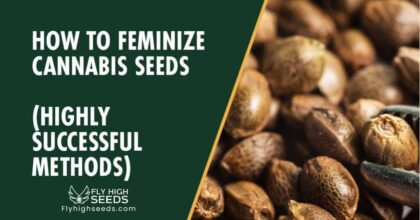
How To Feminize Cannabis Seeds (Highly Successful Methods)

How to Decarb Cannabis [Step-by-Step Guide]
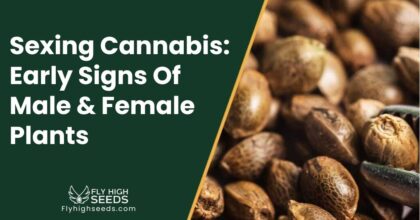
Sexing Cannabis: Early Signs Of Male & Female Plants
CATEGORIES
Best Selling Seeds

